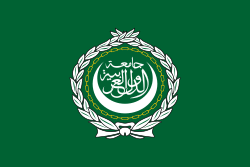Federation of Arab Republics
The Federation of Arab Republics (FAR; Arabic: اتحاد الجمهوريات العربية Ittiḥād al-Jumhūrīyāt al-‘Arabīyah)[1] was an attempt by Muammar Gaddafi to merge Libya, Egypt and Syria in order to create a unified Arab state. Although approved by a referendum in each country on 1 September 1971,[2] the three countries disagreed on the specific terms of the merger. The federation lasted from 1 January 1972 to 19 November 1977.
Federation of Arab Republics اتحاد الجمهوريات العربية Ittiḥād al-Jumhūrīyāt al-‘Arabīyah | |||||||||||||||||
|---|---|---|---|---|---|---|---|---|---|---|---|---|---|---|---|---|---|
| 1972–1977 | |||||||||||||||||
.svg.png) Flag
 Coat of arms
| |||||||||||||||||
.svg.png) The Federation of Arab Republics in 1972. | |||||||||||||||||
| Capital | Tripoli (Libya) Cairo (Egypt) Damascus (Syria) | ||||||||||||||||
| Common languages | Arabic | ||||||||||||||||
| Government | Republic under a confederation | ||||||||||||||||
| Legislature | Federal National Assembly | ||||||||||||||||
| Historical era | Arab Cold War | ||||||||||||||||
• Referenda held | 1 September 1971 | ||||||||||||||||
• Federation established | 1 January 1972 | ||||||||||||||||
• Disestablished | 19 November 1977 | ||||||||||||||||
| Area | |||||||||||||||||
| 1977 | 2,947,171 km2 (1,137,909 sq mi) | ||||||||||||||||
| Population | |||||||||||||||||
• 1977 | 52,703,600 | ||||||||||||||||
| Currency | Libyan dinar Egyptian pound Syrian pound | ||||||||||||||||
| |||||||||||||||||
| Today part of | |||||||||||||||||
| Part of a series on | ||||||||
| Arab League | ||||||||
|---|---|---|---|---|---|---|---|---|
 | ||||||||
|
Issues
|
||||||||
|
||||||||
|
Governance
|
||||||||
|
||||||||
|
||||||||
|
||||||||
|
|
||||||||
|
||||||||
|
Culture
|
||||||||
History
In 1969, Arab nationalist military officers seized power in Libya. The ideological influence of Egyptian President Gamal Abdel Nasser over the new Libyan government was immediately apparent.[3] The administration was immediately recognized by the Arab nationalist governments in Egypt, Iraq, Sudan and Syria[4] with Egypt sending experts to aid Libya's inexperienced government.[5] Gaddafi propounded Pan-Arab ideas, proclaiming the need for a single Arab state stretching across North Africa and the Middle East. In December 1969, Libya founded the Arab Revolutionary Front with Egypt and Sudan as a step towards political unification, and in 1970 Syria stated its intention to join.[6]
After Nasser's death in November 1970, his successor, Anwar Sadat, suggested that rather than a unified state, they create a political federation. It was implemented in April 1971 which enabled Egypt, Syria and Sudan merger, but it was never implemented as relations broke down the following year. Sadat became increasingly wary of Libya's radical direction, and the September 1973 deadline for implementing the Federation passed by with no action taken.[7] In October 1973 Egypt and Syria, without consulting Libya, launched a co-ordinated attack on Israel, initiating the Yom Kippur War.[8] Sadat agreed to open negotiations with Israel, seeking the return of the Sinai Peninsula to Egypt in exchange for a guarantee to not engage in further attacks on the country.[9] Gaddafi was angered by the war's limited objectives and the ceasefire, and accused Sadat of cowardice, undermining the FAR,[10] and betraying the Arab cause.[11] Sadat responded by revealing he had intervened earlier that year to prevent Libya from sinking a civilian passenger ship carrying Jewish tourists in the Mediterranean Sea. Thereafter Egyptian–Libyan relations were marked by frequent accusations against each country's leaders, and further discussions regarding the pursuit of unity were abandoned.[12]
Referendums
Three simultaneous referendums on the Federation of Arab Republics were held on 1 September 1971, in Egypt, Libya and Syria.[13] In the Egyptian referendum the proposal was approved by 99.96% of voters,[14] in the Libyan referendum it was approved by 98.6% of voters,[15] whilst in Syria 96.4% voted in favour.[16]
Other Federations of Arab Republics
- Federation between Egypt, Libya and Sudan (1969/70–1971)
- Federation between Egypt, Libya and Syria (1971/72–1974/77)
- Union between Egypt and Libya within the Federation (1972–1973/74)
- Union between Egypt and Syria within the Federation (1976–1977)
- Federation between Egypt, Sudan and Syria (1977)
See also
- Union of Arab Republics, Iraqi counter-proposal to the Federation of Arab Republics
- Arab Federation, a confederation between Iraq and Jordan (1958)
- Arab Islamic Republic, a proposed union of Libya and Tunisia (1972)
- United Arab Emirates, a union of seven Arab states (1971–present day)
- United Arab Republic, a union between Egypt and Syria (1958–61)
- United Arab States, a confederation between the United Arab Republic and the Kingdom of Yemen (1958–61)
- Unified Political Command, merger projects between Egypt and Iraq as well as between Egypt and North Yemen
| Wikimedia Commons has media related to Federation of Arab Republics. |
References
- The literal translation is "Union of Arab Republics".
- Nohlen, D, Krennerich, M & Thibaut, B (1999) Elections in Africa: A data handbook, p336 ISBN 0-19-829645-2
- Vandewalle 2008, p. 9; Bruce St. John 2012, p. 137.
- Blundy & Lycett 1987, p. 60; Kawczynski 2011, p. 18.
- Blundy & Lycett 1987, pp. 62–63; Kawczynski 2011, p. 18.
- Blundy & Lycett 1987, p. 75; Kawczynski 2011, p. 65; Bruce St. John 2012, p. 186.
- Kawczynski 2011, p. 66; Bruce St. John 2012, p. 182.
- Metz 1989, p. 52.
- Pollack 2004, pp. 131–132.
- Metz 1989, p. 53.
- Pollack 2004, p. 132.
- Metz 1989, pp. 52–53.
- Nohlen, D, Krennerich, M & Thibaut, B (1999) Elections in Africa: A data handbook, p336 ISBN 0-19-829645-2
- Nohlen, D, Krennerich, M & Thibaut, B (1999) Elections in Africa: A data handbook, p340 ISBN 0-19-829645-2
- Nohlen, D, Krennerich, M & Thibaut, B (1999) Elections in Africa: A data handbook, p528 ISBN 0-19-829645-2
- Syrien, 1. September 1971 : Bildung der Vereinigten Arabischen Republik Direct Democracy (in German)
Bibliography
- Blundy, David; Lycett, Andrew (1987). Qaddafi and the Libyan Revolution. Boston and Toronto: Little Brown & Co. ISBN 978-0-316-10042-7.CS1 maint: ref=harv (link)
- Harris, Lillian Craig (1986). Libya: Qadhafi's Revolution and the Modern State. Boulder, Colorado: Westview Press. ISBN 0-8133-0075-4.CS1 maint: ref=harv (link)
- Kawczynski, Daniel (2011). Seeking Gaddafi: Libya, the West and the Arab Spring. Biteback. ISBN 978-1-84954-148-0.CS1 maint: ref=harv (link)
- Vandewalle, Dirk (2008), "Libya's Revolution in Perspective: 1969–2000", Libya Since 1969: Qadhafi's Revolution Revisited, Palgrave Macmillan, pp. 9–53, ISBN 0-230-33750-3CS1 maint: ref=harv (link)
- Metz, Helen Chapin, ed. (1989). Libya: A Country Study. Area Handbook Series (fourth ed.). Washington D. C.: Federal Research Division, Library of Congress. LCCN 88600480.CS1 maint: ref=harv (link)
- Pollack, Kenneth Michael (2004). Arabs at War: Military Effectiveness, 1948–1991. Lincoln, Nebraska: University of Nebraska Press. ISBN 978-0-8032-0686-1.CS1 maint: ref=harv (link)





